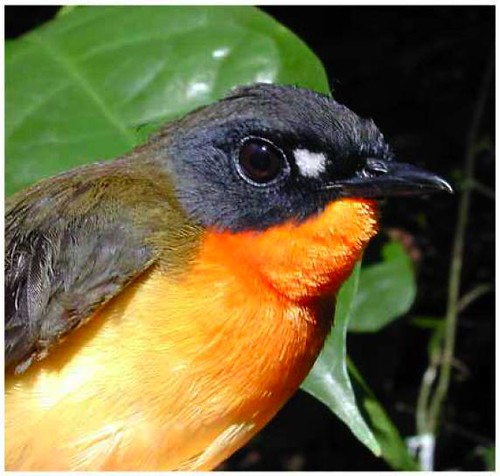tags: new bird species, African forest robin, Stiphrornis pyrrholaemus, Gamba Complex, Moukalaba-Doudou National Park, ornithology, birds, avian, Smithsonian, researchblogging.org
A male specimen of the newly-discovered olive-backed forest robin, Stiphrornis pyrrholaemus, is carefully examined in the hand of Brian Schmidt, the Smithsonian ornithologist who discovered the species.
Image: Brian Schmidt.
A new species of bird has been identified by ornithologists from the Smithsonian Institution. The bird, which was first discovered in Gabon, a small country in Africa, was unknown to the scientific community until now. Interestingly, this species is part of a larger group of closely-related birds in southwest Gabon known as the Gamba Complex.
The new species, which was named the olive-backed forest robin, is a small 4.5 inches long with an average weight of 18 grams. Males have a fiery orange throat and breast, yellow belly, olive back and black feathers on the head. Females are similar, but less vibrant (see image at bottom). Both sexes have a distinctive white dot on their face in front of each eye.
Handheld photographs of male Stiphrornis pyrrholaemus from Moukalaba-Doudou National Park (USNM 631486).
Image: Brian Schmidt.
According to two of my colleagues at the American Museum of Natural History, the Gamba Complex consists of four other distinct members of the genus, Stiphrornis, that are found in primary lowland forest of central and western Africa. All bird species in this complex, including this newest discovery, are fairly common in at least some portions of their ranges, and they all forage unobtrusively on or near the ground.
The new bird species was first observed by Smithsonian scientists in 2001 during a field expedition of the National Zoo's Monitoring and Assessment of Biodiversity Program in southwest Gabon. These birds were initially collected in two locations during a biological survey of tropical rainforest species in central Africa (figure 1);
[larger view].
Originally, it was thought that these specimens were immature individuals of an already-known species. However, Brian Schmidt, a research ornithologist at the Smithsonian's National Museum of Natural History and a member of the National Zoo's Monitoring and Assessment of Biodiversity (MAB) Program's team, realized he had found something new after he compared several specimens to those already in the Smithsonian's bird collection.
"I suspected something when I found the first bird in Gabon since it didn't exactly match any of the species descriptions in the field guides," said Schmidt. "Once I was able to compare them side by side to other specimens in our collections it was clear that these birds were special. You, of course, have to be cautious, but I was still very excited at the prospect of possibly having found a new species of bird."
The scientists gathered some behavioral data from these birds while they were in the field: they recorded two songs produced by this species (figure 4);
[larger view].
As you can see from the spectrograms, the "Type A" song begins with a few high-pitched chirps and continues with a series of modulated notes while the "Type B" song is a rolling trill without any introductory notes. These vocalizations are distinctly different from those produced by two other closely-related species in the Gamba Complex.
To ensure that the specimens Schmidt collected were a new species and to determine how these birds are related to the others in the Gamba Complex, molecular biologists at the Smithsonian's National Zoo sequenced and compared fragments of mitochondrial (cytb and ND5) and nuclear (tRNA-thr) DNA from 17 of the new specimens to the same DNA regions from the four known forest robin species in the Gamba COmplex. The results clearly showed that these birds were in fact a separate and distinct species (figure 5);
[larger view].
The DNA data further indicate that the newly discovered S. pyrrholaemus diverged between 2.7 and 3.4 million years (My) from its next closest relative in the Gamba Complex, S. erythrothorax and between 2.9 and 3.6 My from S. gabonensis, another close relative.
"This discovery is very exciting for us," said Alfonso Alonso, who directs the Biodiversity Program in Gabon. "Finding the olive-backed forest robin strongly underscores the importance of our research. This helps us show the conservation importance of the area."
This area of Africa is remote and generally inhospitable and thus is not well known scientifically. However, intensive logging and industrialization are already making extensive inroads into these forests, which could lead to the rapid decline and extinction of animal and plant species before they are even described and studied by scientists.
"Although finding an unknown species like the olive-backed forest robin was not the goal of the MAB project," Schmidt said, "it is definitely a reminder that the world still holds surprises for us."
Although less vibrant than the male olive-backed forest robin, Stiphrornis pyrrholaemus, this female still exhibits a bright orange and yellow throat and distinctive white dot in front of each eye.
Image: Carlton Ward.
Source
Schmidt, B.K., Foster, J.T., Angehr, G.R., Durrant, K.L., Fleischer, R.C. (2008). A new species of African Forest Robin from Gabon (Passeriformes: Muscicapidae: Stiphrornis). Zootaxa, 1850, 27-42 [free PDF].







I know it's not the most intelligent thing to say, but what a gorgeous little fellow!
Yes, "world still holds surprises," and this surprise has been held for 5/+ years already! I know that research requires patience, but they took some time.
Ah, nothing wrong with saying that these have the appearance of sweet little angels. The hen pictured has feet like a canary.
And it's not even red-listed (yet)!
Actually, the only forest robin in the red list is the forest robin, which is classed as LC, Least Concern. So I guess we can go out ans shoot the buggers.
Hi there - happy to let you know that this post is now included in the Beautiful Africa Blog Carnival at http://belleafrique.blogspot.com/2008/08/beautiful-africa-9th-edition.h….
Thanks again for a great post!